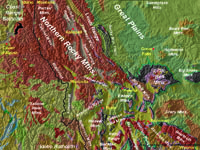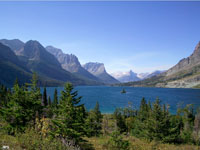
Regional Geology of North America |
|
Northern Rocky Mountains |
Click on images for a
larger view. |
The Northern Rocky Mountains include ranges in western Montana (north of Yellowstone National Park) and extending northward into Alberta, Canada (Figure 123). The region was impacted by both the Sevier and Laramide Orogenies. The Lewis Mountains in northern Montana started forming about 140 million years ago as a great slab of sedimentary rocks of Precambrian age (about 3 miles thick) was thrust eastward over rocks of Cretaceous age. Alpine glaciers during the Pleistocene Epoch have carved the Northern Rocky Mountains, resulting in the spectacular scenery of Glacier National Park (Figure 124).
Mountain ranges in southwestern Montana are still actively forming in association with both the Yellowstone Hotspot activity and crustal extension associated with the basin-and-range tectonism of Great Basin Province to the southwest in southern Idaho. |
 |
 |
| Fig. 123. Northern Rocky Mountains region in Montana and Idaho. The Northern Rockies extend northward into Alberta and British Columbia. |
Fig. 124. Pleistocene glaciers carved Precambrian sedimentary rocks, now well exposed in Glacier National Park, Montana. |
| https://gotbooks.miracosta.edu/geology/regions/northern_rocky_mountains.html 1/20/2017 |

|
 |
|
|


